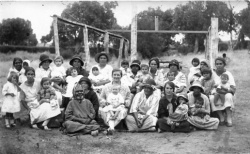Assimilation incorporated several ideas that aimed to ensure that Indigenous people lost their Indigeneity as it was expressed through biology and through culture.
The typical definition of assimilation policies can be seen in this statement from the Australian Aboriginal Affairs Ministers in 1963:
| “
|
The policy of assimilation means that all Aborigines and part-Aborigines will attain the same manner of living as other Australians and live as members of a single Australian community enjoying the same rights and privileges, accepting the same responsibilities, observing the same customs and influenced by the same beliefs, hopes and loyalties as others Australians (as cited in Chesterman & Douglas, 2004, p. 48).
|
”
|

A Point McLeay Aboriginal Mission. Taken around 1920. Now Raukkan Aboriginal Community on Lake Alexandrina near Narrung. A group of female residents of Point McLeay around 1920.
This policy had two strands. As we will address further next week in relation to the Stolen Generations, some policies, particularly in the 1920s-30s, reflected the ideas of “biological absorption”, or “the desired removal of Indigenous physical characteristics”. Simultaneously, other policies emphasised “social integration”, or taking on the social attributes of non-Indigenous society (Chesterman & Douglas, 2004, pp. 48-49). After WWII, ideas about biological absorption were discredited. Social and economic assimilation became the dominant official policy.
As John Chesterman and Heather Douglas argue, ‘the broad attraction of the policy of assimilation was the promise that it held for the ‘ultimate absorption’ (in a cultural, if not in a racial sense) of Aboriginality by white Australia, a promise that would end the myriad headaches being caused by the attempts to separate white and black. But just as biological absorptionists hadn’t counted on the survival of the Aboriginal race, nor did the ascendant social integrationists count on the survival of Indigenous culture.’ (Chesterman & Douglas, 2004, pp. 48-49).
In order to ensure that Indigenous people were adhering to this ‘same manner of living’, assimilation policy focused on surveillance of Indigenous people, with District Welfare Officers appointed to observe and report on Indigenous life. They awarded so-called ‘Exemption Certificates’ to Aboriginal people who were seen as ‘deserving’, which supposedly allowed access to other services which non-Indigenous people took for granted, such as education, housing or health. In order to get an exemption certificate, people had to agree to live separately from other Indigenous people, giving up ties to family and community.
Policy and its implementation
What do you make of the apparent differences between the aims of Protection legislation and policies, the actual practices that occurred due to the legislation, and the effects on peoples’ lives? Create a table to tease these ideas apart. You can add to this table next week.
E.g:
|
Aim of legislation
|
Practices
|
Effects on People
|
- To make the passing away of the last Aborigines more ‘humane’
|
- Provide places where Aboriginal people could live out their last days
- Force Aboriginal people to live in certain places
|
- Removed from own country
- Loss of cultural connection and ability to educate children about and on country
- Unable to practice land management including ceremonies
- Tension as different language groups forced to live together
- Challenging kinship connections and marriage laws.
|
Record some of your observations in your reflections.
Key Idea
Assimilation incorporated several ideas that aimed to ensure that Indigenous people lost their Indigeneity as it was expressed through biology and through culture.
The typical definition of assimilation policies can be seen in this statement from the Australian Aboriginal Affairs Ministers in 1963:
This policy had two strands. As we will address further next week in relation to the Stolen Generations, some policies, particularly in the 1920s-30s, reflected the ideas of “biological absorption”, or “the desired removal of Indigenous physical characteristics”. Simultaneously, other policies emphasised “social integration”, or taking on the social attributes of non-Indigenous society (Chesterman & Douglas, 2004, pp. 48-49). After WWII, ideas about biological absorption were discredited. Social and economic assimilation became the dominant official policy.
As John Chesterman and Heather Douglas argue, ‘the broad attraction of the policy of assimilation was the promise that it held for the ‘ultimate absorption’ (in a cultural, if not in a racial sense) of Aboriginality by white Australia, a promise that would end the myriad headaches being caused by the attempts to separate white and black. But just as biological absorptionists hadn’t counted on the survival of the Aboriginal race, nor did the ascendant social integrationists count on the survival of Indigenous culture.’ (Chesterman & Douglas, 2004, pp. 48-49).
In order to ensure that Indigenous people were adhering to this ‘same manner of living’, assimilation policy focused on surveillance of Indigenous people, with District Welfare Officers appointed to observe and report on Indigenous life. They awarded so-called ‘Exemption Certificates’ to Aboriginal people who were seen as ‘deserving’, which supposedly allowed access to other services which non-Indigenous people took for granted, such as education, housing or health. In order to get an exemption certificate, people had to agree to live separately from other Indigenous people, giving up ties to family and community.
Required Reading
Even people who were apparently sympathetic to the plight of Aboriginal peoples could support harsh measures to effect assimilation. Read this pamphlet for one striking example:
Read, P. (1983). ‘A rape of the soul so profound’: some reflections on the dispersal policy in New South Wales. In Aboriginal History. Vol. 7. p.23-33.
Learning Activity
Policy and its implementation
What do you make of the apparent differences between the aims of Protection legislation and policies, the actual practices that occurred due to the legislation, and the effects on peoples’ lives? Create a table to tease these ideas apart. You can add to this table next week.
E.g:
Aim of legislation
Record some of your observations in your reflections.
Content is available under the
Creative Commons Attribution Share Alike License.
Privacy Policy | Authors